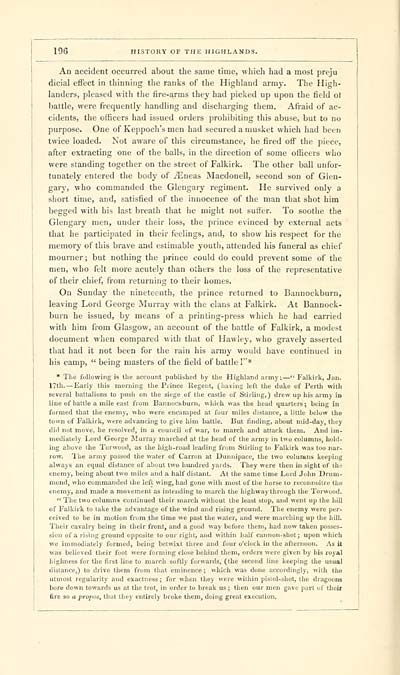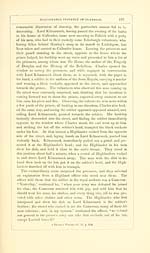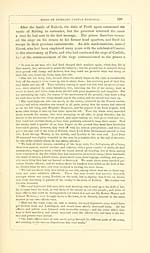Download files
Complete book:
Individual page:
Thumbnail gallery: Grid view | List view

196
HISTORY OF THE HIGHLANDS.
An accident occurred about the same time, wliich had a most preju
dicial effect in thinning the ranks of the Highland army. The High-
landers, pleased with the fire-arms they had picked up upon the field ol
hattle, were frequently handling and discharging them. Afraid of ac-
cidents, the officers had issued orders prohibiting this abuse, but to no
purpose. One of Keppoch's men had secured a musket which had been
twice loaded. Not aware of this circumstance, he fired off the piece,
after extracting one of the balls, in the direction of some officers who
were standing together on the street of Falkirk. The other ball unfor-
tunately entered the body of jEneas Macdonell, second son of Glen-
garj', who commanded the Glengary regiment. He survived only a
short time, and, satisfied of the innocence of the man that shot him
begged with his last breath that he might not suffer. To soothe the
Glengary men, under their loss, the prince evinced by external acts
that he participated in their feelings, and, to show his respect for the
memory of this brave and estimable youth, attended his funeral as chief
mourner ; but nothing the prince could do could prevent some of the
men, who felt more acutely than others the loss of the representative
of their chief, from returning to their homes.
On Sunday the nineteenth, the prince returned to Bainiockburn,
leaving Lord George Murray with the clans at Falkirk. At Bannock-
burn he issued, by means of a printing-press which he had carried
with him from Glasgow, an account of the battle of Falkirk, a modest
document when compared with that of Hawley, who gravely asserted
that had it not been for the rain his army would have continued in
his camp, " being masters of the field of battle I"*
* The following is the account published by Uie Highland army: — '* Falkirk, Jan.
17tb.— Early this moniing the Prince Regent, (having left the duke of Perth with
several battalions to push on the siege of the castle of Stirling,) drew up his army in
line of battle a mile east from Bannochburn, which was the head quarters; being in
formed that the enem_>', who were encamped at four miles distance, a little below the
town of Falkirk, were advancing to give him battle. But finding, about mid-day, they
did not move, he resolved, in a council of war, to march and attack them. And im-
mediately Lord George Murray marched at the head of the army in two columns, hold-
ijig above the Torwood, as the high-road leading from Stirling to Falkirk was too nar-
row. I'he army passed tlie water of Carron at Dunnipace, the two columns keeping
always an equal distance of about two hundred yards. They were then in sight of the
enemy, being about two miles and a half distant. At the same time Lord John Drum-
mond, who commanded ihe left wing, had gone with most of the horse to reconnoitre the
enemy, and made a movement as intending to march the highway through tlie Torwood.
" The two columns continued their march without the least stop, and went up the hill
of Falkirk to lake the advantage of the wind and rising ground. The enemy were per-
ceived to be in motion from the time we past tlie water, and were marching up the hill.
Tlieir cavalry being in their front, and a good way before them, liad now taken posses-
sion of a rising ground opposite to our right, and witliin half cannon-shot ; upon which
we immediately formed, being betwixt three and four o'clock in tlie afternoon. As it
was believed their foot were forming close behind tliem, orders were given by his royal
highness for the first line to march softly forwards, (tlie second line keeping tlie usual
distance,) to drive them from that eminence; which was done accordingly, with the
utmost regularity and exactness ; for when they were within pislnl-shot, the dragoons
bore down towards us at the trot, in order to break us ; then our men gave part of Uieif
fire so a propos, that they entirely broke them, doing great execution.
HISTORY OF THE HIGHLANDS.
An accident occurred about the same time, wliich had a most preju
dicial effect in thinning the ranks of the Highland army. The High-
landers, pleased with the fire-arms they had picked up upon the field ol
hattle, were frequently handling and discharging them. Afraid of ac-
cidents, the officers had issued orders prohibiting this abuse, but to no
purpose. One of Keppoch's men had secured a musket which had been
twice loaded. Not aware of this circumstance, he fired off the piece,
after extracting one of the balls, in the direction of some officers who
were standing together on the street of Falkirk. The other ball unfor-
tunately entered the body of jEneas Macdonell, second son of Glen-
garj', who commanded the Glengary regiment. He survived only a
short time, and, satisfied of the innocence of the man that shot him
begged with his last breath that he might not suffer. To soothe the
Glengary men, under their loss, the prince evinced by external acts
that he participated in their feelings, and, to show his respect for the
memory of this brave and estimable youth, attended his funeral as chief
mourner ; but nothing the prince could do could prevent some of the
men, who felt more acutely than others the loss of the representative
of their chief, from returning to their homes.
On Sunday the nineteenth, the prince returned to Bainiockburn,
leaving Lord George Murray with the clans at Falkirk. At Bannock-
burn he issued, by means of a printing-press which he had carried
with him from Glasgow, an account of the battle of Falkirk, a modest
document when compared with that of Hawley, who gravely asserted
that had it not been for the rain his army would have continued in
his camp, " being masters of the field of battle I"*
* The following is the account published by Uie Highland army: — '* Falkirk, Jan.
17tb.— Early this moniing the Prince Regent, (having left the duke of Perth with
several battalions to push on the siege of the castle of Stirling,) drew up his army in
line of battle a mile east from Bannochburn, which was the head quarters; being in
formed that the enem_>', who were encamped at four miles distance, a little below the
town of Falkirk, were advancing to give him battle. But finding, about mid-day, they
did not move, he resolved, in a council of war, to march and attack them. And im-
mediately Lord George Murray marched at the head of the army in two columns, hold-
ijig above the Torwood, as the high-road leading from Stirling to Falkirk was too nar-
row. I'he army passed tlie water of Carron at Dunnipace, the two columns keeping
always an equal distance of about two hundred yards. They were then in sight of the
enemy, being about two miles and a half distant. At the same time Lord John Drum-
mond, who commanded ihe left wing, had gone with most of the horse to reconnoitre the
enemy, and made a movement as intending to march the highway through tlie Torwood.
" The two columns continued their march without the least stop, and went up the hill
of Falkirk to lake the advantage of the wind and rising ground. The enemy were per-
ceived to be in motion from the time we past tlie water, and were marching up the hill.
Tlieir cavalry being in their front, and a good way before them, liad now taken posses-
sion of a rising ground opposite to our right, and witliin half cannon-shot ; upon which
we immediately formed, being betwixt three and four o'clock in tlie afternoon. As it
was believed their foot were forming close behind tliem, orders were given by his royal
highness for the first line to march softly forwards, (tlie second line keeping tlie usual
distance,) to drive them from that eminence; which was done accordingly, with the
utmost regularity and exactness ; for when they were within pislnl-shot, the dragoons
bore down towards us at the trot, in order to break us ; then our men gave part of Uieif
fire so a propos, that they entirely broke them, doing great execution.
Set display mode to: Large image | Transcription
Images and transcriptions on this page, including medium image downloads, may be used under the Creative Commons Attribution 4.0 International Licence unless otherwise stated. ![]()
| Early Gaelic Book Collections > Ossian Collection > History of the Highlands and of the Highland clans > Volume 3 > (226) |
|---|
| Permanent URL | https://digital.nls.uk/79655134 |
|---|
| Description | Vol. III. |
|---|---|
| Shelfmark | Oss.249 |
| Attribution and copyright: |
|
| Description | Selected books from the Ossian Collection of 327 volumes, originally assembled by J. Norman Methven of Perth. Different editions and translations of James MacPherson's epic poem 'Ossian', some with a map of the 'Kingdom of Connor'. Also secondary material relating to Ossianic poetry and the Ossian controversy. |
|---|
| Description | Selected items from five 'Special and Named Printed Collections'. Includes books in Gaelic and other Celtic languages, works about the Gaels, their languages, literature, culture and history. |
|---|

